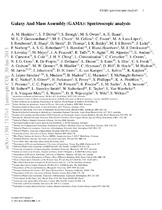| dc.contributor.author | Hopkins, A.M. | |
| dc.contributor.author | Driver, S.P. | |
| dc.contributor.author | Brough, S. | |
| dc.contributor.author | Jarvis, Matt | |
| dc.date.accessioned | 2018-02-15T13:27:22Z | |
| dc.date.available | 2018-02-15T13:27:22Z | |
| dc.date.issued | 2013 | |
| dc.identifier.citation | Hopkins, A.M. et al. (2013). Galaxy And Mass Assembly (GAMA): spectroscopic analysis. Monthly Notices of the Royal Astronomical Society, 430(3): 2047 - 2066 | en_US |
| dc.identifier.issn | 0035-8711 | |
| dc.identifier.uri | http://dx.doi.org/10.1093/mnras/stt030 | |
| dc.identifier.uri | http://hdl.handle.net/10566/3497 | |
| dc.description.abstract | The Galaxy And Mass Assembly (GAMA) survey is a multiwavelength photometric and spectroscopic
survey, using the AAOmega spectrograph on the Anglo-Australian Telescope to obtain
spectra for up to _ 300 000 galaxies over 280 square degrees, to a limiting magnitude of
rpet < 19.8mag. The target galaxies are distributed over 0 < z . 0.5 with a median redshift
of z _ 0.2, although the redshift distribution includes a small number of systems, primarily
quasars, at higher redshifts, up to and beyond z = 1. The redshift accuracy ranges from
σv _ 50 kms−1 to σv _ 100 kms−1 depending on the signal-to-noise of the spectrum. Here
we describe the GAMA spectroscopic reduction and analysis pipeline. We present the steps
involved in taking the raw two-dimensional spectroscopic images through to flux-calibrated
one-dimensional spectra. The resulting GAMA spectra cover an observed wavelength range
of 3750 . λ . 8850 °A at a resolution of R _ 1300. The final flux calibration is typically
accurate to 10 − 20%, although the reliability is worse at the extreme wavelength ends, and
poorer in the blue than the red. We present details of the measurement of emission and absorption
features in the GAMA spectra. These measurements are characterised through a variety
of quality control analyses detailing the robustness and reliability of the measurements. We
illustrate the quality of the measurements with a brief exploration of elementary emission line
properties of the galaxies in the GAMA sample. We demonstrate the luminosity dependence
of the Balmer decrement, consistent with previously published results, and explore further
how Balmer decrement varies with galaxy mass and redshift. We also investigate the mass
and redshift dependencies of the [NII]/Hα vs [OIII]/Hβ spectral diagnostic diagram, commonly
used to discriminate between star forming and nuclear activity in galaxies. | en_US |
| dc.language.iso | en | en_US |
| dc.publisher | Oxford University Press | en_US |
| dc.rights | This is the pre-print version (From arXiv:1301.7127) of the article available online at: http://dx.doi.org/10.1093/mnras/stt030 | |
| dc.subject | Galaxies | en_US |
| dc.subject | Evolution | en_US |
| dc.subject | Formation | en_US |
| dc.title | Galaxy And Mass Assembly (GAMA): spectroscopic analysis | en_US |
| dc.type | Article | en_US |
| dc.privacy.showsubmitter | FALSE | |
| dc.status.ispeerreviewed | TRUE | |
| dc.description.accreditation | Web of Science | |

